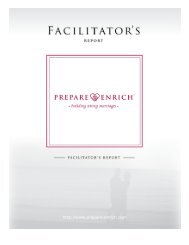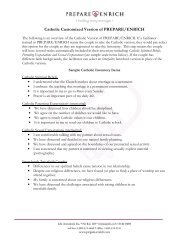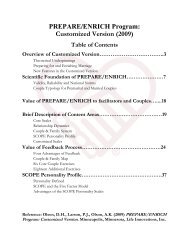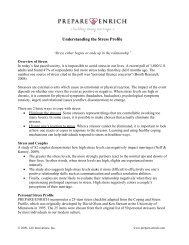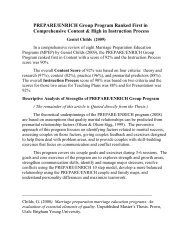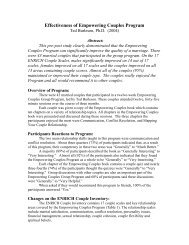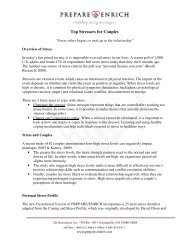Birth Order and Couple Satisfaction (click here) - Prepare-Enrich
Birth Order and Couple Satisfaction (click here) - Prepare-Enrich
Birth Order and Couple Satisfaction (click here) - Prepare-Enrich
Create successful ePaper yourself
Turn your PDF publications into a flip-book with our unique Google optimized e-Paper software.
5Figure 2 PREPARE/ENRICH <strong>Couple</strong> Types <strong>and</strong> Marital <strong>Satisfaction</strong>PREPARE/ENRICH is a premarital <strong>and</strong> marital assessment that identifies the couplestrengths <strong>and</strong> growth areas to work on in their relationship. It also categorizes their relationshipinto a typology called the Five <strong>Couple</strong> Types. The ENRICH couple types are categorized formarried couples. These types include two types that are “more intimate” couples: Vitalized <strong>and</strong>Harmonious; a “moderately intimate” couple type: Traditional; <strong>and</strong> two “less intimate” types:Conflicted <strong>and</strong> Devitalized (see Figures 1 <strong>and</strong> 2).Vitalized Type. Vitalized couples are “the most intimate <strong>and</strong> skilled of the types…themost successful in preventing stressors from interfering with their relationship” (Kouneski &Olson, 2004). They are the most emotionally connected <strong>and</strong> are flexible in adapting to stress<strong>and</strong> transitions in their relationships. They both have high levels of self confidence. They alsoare the most satisfied <strong>and</strong> have the lowest risk of divorce (see Figure 2).Harmonious Type. Harmonious couples are “somewhat skilled in communication <strong>and</strong>conflict resolution…have moderate to high levels of intimacy…[<strong>and</strong>] tend to experience moresexual <strong>and</strong> social, than spiritual <strong>and</strong> recreational, intimacies”. Often, they do not agree onchildren <strong>and</strong> parenting. They are nearly as close but not as flexible as vitalized couples, whichsuggests that harmonious couples may have difficulties resolving issues. Harmonious couplesalso have a strong sense of togetherness, but need to increase flexibility in the relationship.Conventional Type. Traditional couples are “moderately skilled in communication <strong>and</strong>conflict resolution…experience high levels of spiritual <strong>and</strong> social intimacies…[<strong>and</strong>] are highlycompatible on values related to children <strong>and</strong> parenting”. Traditional couples have socialsupport from friends <strong>and</strong> family, but support within the relationship is unclear; they experience
6closeness but not much flexibility. Assertiveness is low, <strong>and</strong> they are not highly responsive toeach other’s needs.Conflicted Type. Conflicted couples “are much less skilled in communication <strong>and</strong> conflictresolution” than the previous three types (p. 124). They experience low levels of intimacy inevery form <strong>and</strong> are much less emotionally connected <strong>and</strong> flexible than the more intimate types.The most problematic stressors appear to be personality issues (moodiness, stubbornness,jealousy). Spiritual intimacy ranks highest above all others.Devitalized Type. Devitalized couples are “discouraged, either unmotivated or unwillingto develop communication <strong>and</strong> conflict resolution skills for the relationship…they experiencethe lowest levels of intimacy <strong>and</strong> have less capacity to deal with stressors” than the four othertypes (p. 124). Major stressors include personality issues, financial management, <strong>and</strong> children<strong>and</strong> parenting. Devitalized couples are the least close (disengaged) <strong>and</strong> the least flexible (rigid).They are the most likely to avoid communication <strong>and</strong> perceive disrespect from their partner.Hypotheses:T<strong>here</strong> are different ideas that are used in everyday life about how one can attainrelationship satisfaction. The most prominent two are “opposites attract” <strong>and</strong> “birds of afeather flock together”. These concepts claim that the best partnerships are either those inwhich both partners are either very similar or very different. The current study investigates ifthe birth order combination in partners has an effect on relationship intimacy according to theFive <strong>Couple</strong> Types from PREPARE/ENRICH. The hypotheses testing couple pairing include:1. The most common pairing will be same birth order couples.2. The most uncommon pairing will be homogenous only‐child couples.Is intimacy related to how similar or different a couple is from each other? Those whomarry someone who is of the same birth order may be more volatile. According to Leman(1998), “the most competitive, most volatile, <strong>and</strong> most discouraged are combinations w<strong>here</strong>both spouses are first borns, or worse, both are only children” (p. 207). This may suggest thatall same‐birth order couples have a less intimate marital relationship. The hypotheses testingintimacy according t the PREPARE/ENRICH marital typology <strong>and</strong> satisfaction include:3. <strong>Couple</strong>s who are of the same birth order will have a less intimate marital typology.4. <strong>Couple</strong>s who are of the same birth order will have a lower individual <strong>and</strong> couple(PCA) satisfaction scores than heterogeneous couples.As described by Allred <strong>and</strong> Poduska (1988), birth order <strong>and</strong> gender may have an effecton a person’s happiness. The following hypotheses will try to determine if the same affects willbe found in marital satisfaction as were found in happiness:5. Second‐born females will be more satisfied in their marriage than firstborn females.6. Males will be more satisfied in their marriage than females.
8form of Revised Individual (REV) Scores (correction based on Idealistic Distortion)for the male<strong>and</strong> female <strong>and</strong> Positive <strong>Couple</strong> Agreement (PCA) Scores to determine the couple’s agreementin the various areas of couple functioning.ProcedureThe survey items used for birth order were “What is your birth position in your family”<strong>and</strong> “Number of children in your family”. The second item was used to determine if a personwho answered they are a “first born child” was an only child (one child in their family).Homogeneous couples who were fourth or fifth or more in their birth order weregrouped into the “other category” for all analyses, along with heterogeneous birth orderpaired couples. These birth orders were much less frequent than first‐, second‐, <strong>and</strong> third‐bornchildren. Same birth order couples who were fourth‐ or fifth‐ or more were included in thefrequency statistics. Only children <strong>and</strong> firstborns are mutually exclusive.The first analysis for hypotheses One, Two <strong>and</strong> Three was completed by running afrequency analysis to determine how many same birth‐order (homogenous) couples wereparts of the sample.The second analysis for hypotheses Four, Five <strong>and</strong> Six was completed by running a casesummary for the mean individual satisfaction scores for males <strong>and</strong> females, as well as themean Positive <strong>Couple</strong> Agreement (PCA) score for couple satisfaction. These were done forhomogenous <strong>and</strong> heterogeneous couples.ResultsHypothesis 1The most common paring will be same birth order couplesFrequency Percent Valid Percent CumulativePercentValidBoth Only Child 435 4.4 4.4 4.4Both First Born 1280 12.8 12.8 17.2Both 2 nd Born 933 9.3 9.3 26.5Both 3 rd Born 276 2.8 2.8 29.2Both 4 th Born 48 .5 .5 29.7Both 5 th Born 93 .9 .9 30.7Other 6935 69.4 69.4 100.0Total 10000 100.0 100.0Table 1: Frequency of <strong>Couple</strong> Pairings
9As Table 1 shows, the most common pairing was not same birth order couples. About 70percent (69.4%) of the total sample was a part of a couple in which partners were not of thesame birth order. The most common same birth order pair was first born paired couples(17.2%), followed by homogenous second‐born couples (9.3%).Hypothesis 2The most uncommon pairing will be homogenous only child couples.As shown by Table 1, couples made of two only children were not the most uncommonpairing in this sample, disproving the hypothesis. The most uncommon pairing was fourth‐bornpaired couples (.5%).Hypothesis 3<strong>Couple</strong>s who are of the same birth order will have a less intimate marital typology<strong>Couple</strong> TypeVITALIZEDCount% within <strong>Birth</strong> <strong>Order</strong>HARMONIOUSCount% within <strong>Birth</strong> <strong>Order</strong>CONVENTIONALCount% within <strong>Birth</strong> <strong>Order</strong>CONFLICTEDCount% within <strong>Birth</strong> <strong>Order</strong>DEVITALIZEDCount% within <strong>Birth</strong> <strong>Order</strong>TotalCount% within <strong>Birth</strong> <strong>Order</strong><strong>Birth</strong> orderFirst Born 2 nd Born 3 rd Born Other Total32318.8%33719.7%35220.5%34620.2%35720.8%1715100.0%19320.7%17819.1%18219.5%20121.5%17919.2%933100.0%5218.8%6122.1%5519.9%5821.0%5018.1%276100.0%143220.2%142420.1%141119.9%139519.7%141420.0%7076100.0%Table 2: Frequency of <strong>Birth</strong> <strong>Order</strong> Paired <strong>Couple</strong>s within the Five Married <strong>Couple</strong> Types200020.0%200020.0%200020.0%200020.0%200020.0%10000100.0%<strong>Couple</strong>s who were of the same birth order did not have a less intimate marital typologythan those who were married to couples of mixed birth order pairing as hypothesized (SeeTable 2). A chi‐square value of 6.2 was not significant (p>.90). Percentage frequencies forfirstborn/firstborn couples across the five typologies ranged from 18.8%‐ 20.8%. Percentagefrequencies for second‐born paired couples ranged from 19.1%‐21.5%. Percentage frequencies
10for third‐born paired couples ranged from 18.1%‐22.1%. No birth order pairing had significantlymore couples in any one of the five marital types.<strong>Couple</strong> TypeVITALIZEDCount% within <strong>Birth</strong> <strong>Order</strong>HARMONIOUSCount% within <strong>Birth</strong> <strong>Order</strong>CONVENTIONALCount% within <strong>Birth</strong> <strong>Order</strong>CONFLICTEDCount% within <strong>Birth</strong> <strong>Order</strong>DEVITALIZEDCount% within <strong>Birth</strong> <strong>Order</strong>TotalCount% within <strong>Birth</strong> <strong>Order</strong>Only Child8419.3%8519.5%7617.5%8118.6%10925.1%435100.0%<strong>Birth</strong> <strong>Order</strong>First Born not only child31118.9%31719.2%34320.8%33820.5%33920.6%1648100.0%Table 3: Frequency of Only Children vs. First Borns <strong>and</strong> <strong>Couple</strong> TypeTotal39519.0%40219.3%41920.1%41920.1%44821.5%2083100.0%When comparing only child paired couples, the results were similar, as shown in Table 3.A noteworthy result, although not statistically significant, is that homogenous only‐childcouples had a higher frequency of Devitalized couples (25.1%) than the other birth orderhomogeneous <strong>and</strong> heterogeneous combinations.
11Hypothesis 4<strong>Couple</strong>s who are of the same birth order will have a lower individual <strong>and</strong> couple (PCA)satisfaction scores than heterogeneous couples.<strong>Birth</strong> <strong>Order</strong> Mean N* First Born 46.7 17132 nd Born 45.7 9333 rd Born 45.9 276Other 45.8 7073Total 45.9 9995Table 4: Male Independent<strong>Satisfaction</strong> Score<strong>Birth</strong> <strong>Order</strong> Mean N*First Born 45.2 17172 nd Born 44.7 9333 rd Born 43.2 276Other 45.9 7079Total 45.5 10005Table 5: Female Independent <strong>Satisfaction</strong> Score<strong>Birth</strong> <strong>Order</strong> Mean N*First Born 39.7 17152 nd Born 38.8 9333 rd Born 38.7 276Other 39.9 7076Total 39.7 10000Table 6: Mean <strong>Couple</strong> <strong>Satisfaction</strong> (PCA Score)Married couples who both are of the same birth order do not have a lower meanindividual satisfaction score or PCA Score, as indicated by Tables 4, 5 <strong>and</strong> 6. (<strong>Satisfaction</strong> scoresare scored on a continuous scale from 0.0‐100.0). Table 6 compares the PCA scores ofhomogeneous firstborn, second born, third born <strong>and</strong> heterogeneous birth order paired couples.Hypothesis 5Second‐born females will be more satisfied in their marriage than firstborn females.As shown in Table 5, second‐born females (44.7) are not any more satisfied in theirmarriage than are firstborn females (45.2). In fact, across the birth orders, t<strong>here</strong> was nostatistically significant difference in mean satisfaction scores for females.Hypothesis 6Males will be more satisfied with their marriage than femalesAs can be seen by comparing Table 4 <strong>and</strong> Table 5, gender does not have a significantaffect in satisfaction scores (male, 45.9; female, 45.5).* Includes Only Children
12DiscussionThe current study examined a r<strong>and</strong>om sample of 10,000 married couples to test if birthorder has an effect on marital satisfaction at the individual <strong>and</strong> couple level. It also attemptedto discover if couples of the same birth order had a higher level of marital satisfaction thanthose who did not have a spouse of the same birth order, as well as the general question thatpeople are attracted to those who are similar to themselves. The hypotheses tested regardedindividual <strong>and</strong> couple satisfaction <strong>and</strong> the five types of married couples from PREPARE/ENRICH.This study found that birth order has no significant effect on marriage intimacy <strong>and</strong>satisfaction. The stratified sample illustrates that homogenous birth order couples do not fallinto a more or less satisfied PREPARE/ENRICH marital type than heterogeneous birth ordercouples. In contradiction to Allred <strong>and</strong> Poduska (1988), birth order does not have an effect onmarital satisfaction. While this study looked only at marital satisfaction <strong>and</strong> Allred <strong>and</strong> Poduskalooked <strong>and</strong> overall happiness, it could be thought that the two would be related. T<strong>here</strong> was nodifference between men <strong>and</strong> women. The differences could be attributed to sample size or thefact that two different aspects were being studied.Hartshorne, Salem‐Hartshorne <strong>and</strong> Hartshorne (2009) found that people are drawn tothose who are of the birth order in plutonic <strong>and</strong> romantic relationships. The researcherhypothesized that this finding would be replicated in the current study, but it was not. T<strong>here</strong>were not more homogenous couples in this study, in fact t<strong>here</strong> were less. The differences inresults <strong>here</strong> could again be attributed to sample size.One finding that while not statistically significant, but hints at a replicated finding, is thatin couples that were made of two only children t<strong>here</strong> were more Devitalized couples. Thisseems to be congruous with findings by Leman, that homogeneous only child couples are themost volatile combination for couples. Could this be attributed to personality similarities? It issurprising that this finding was not also found in homogeneous firstborn couples or third borncouples since only children are often described as having first or third born personalityqualities.Limitations with this study include that those who take PREPARE/ENRICH are eitherdoing really well in their marriage or are doing poorly. Having a stratified, national sample triedto eliminate this bias, but it is not a truly r<strong>and</strong>om sample. Another limitation is that t<strong>here</strong> hasbeen very little research on the effects of birth order <strong>and</strong> even fewer replicated findings in thefield. Since this is a very new <strong>and</strong> difficult field in psychology, having congruent or significantfindings that are able to be replicated can be difficult. While a sample size of 10,000 couples isvery large, it may have not been large enough to find significant results. It may be possible thatusing a larger sample could reveal results that were not found in this study.The field of birth order psychology offers many future opportunities in research. Theanalyses done in this study could be repeated with a larger sample in order to determine if a
larger sample may yield statistically significant results. The relationship between birth order,personality, <strong>and</strong> marital types or marital satisfaction could also be examined. If one wereinterested in attraction, the same study could be done with dating or engaged couples insteadof married couples. Another future opportunity in this research may focus on whyhomogeneous only child couples are apparently more devitalized than first or third bornhomogenous couples, examining how personality traits in each of the birth orders differ despitethat only children are often compared to first <strong>and</strong> youngest children. T<strong>here</strong> are many differentdirections that could be explored the effects of birth order in couple satisfaction <strong>and</strong> attraction.13
14ResourcesAllred, G.H., & Poduska, B.E. (1988). <strong>Birth</strong> order <strong>and</strong> happiness: a preliminary study. IndividualPsychology, 44(3), 346‐354.Bossard, J. H., & Stoker Boll, E. (1955). Personality roles in the large family. Child Development,26(1), 71‐78.Grattis, K.S., Berns, S., Simpson, L.E., & Christensen, A. (2004). Birds of a feather or strangebirds? Ties among personality dimensions, similarity, <strong>and</strong> marital quality. Journal ofFamily Psychology, 18(4), 564‐574.Griffin, T. L. (2001). The adult‐only child, birth order <strong>and</strong> marital satisfaction as measured by theENRICH couple inventory. (Doctoral dissertation).Hartshorne, J.K., Salem‐Hartshorne, N., & Hartshorne T.S. (2009). <strong>Birth</strong> order effects in theformation of long‐term relationships. Journal of Individual Psychology, 65(2), 156‐176.Jefferson, T., Herbst, J. H., & McCrae, R. R. (1998). Associations between birth order <strong>and</strong>personality traits: Evidence from self‐reports <strong>and</strong> observer ratings. Journal of ResearchKouneski, in Mashek, Personality, E.F., & D.J. Olson, & 32, Aron, D.H. 498‐509. A. (2004). (Eds.), A H<strong>and</strong>book practical look of Closeness at intimacy: <strong>and</strong> ENRICH Intimacy couple (117‐133). typology. Mahwah, InNew Jersey: Lawrence Erlbaum Associates, Inc.Leman,K. (1998). The new birth order book: Why you are the way you are (Rev. ed.). Gr<strong>and</strong>Rapids, MI: Fleming H. Revell.Michalski, R. L., & Shackelford, T. K. (2002). An attempted replication of the relationshipsbetween birth order <strong>and</strong> personality. Journal of Research in Personality, 36, 182‐188.doi:10.1006/jrpe.2001.2350Nyman, L. (1995). The identification of birth order personality attributes. Journal of Psychology,129(1), 51‐59.Olson, D.H., Larson, P.J., & Larson, A.K. (2009) PREPARE/ENRICH: Customized Version.Minneapolis, Minnesota, Life Innovations, Inc.Paulhus, D. L., Trapnell, P. D., & Chen, D. (1999). <strong>Birth</strong> order effects on personality <strong>and</strong>achievement within families. Psychological Science, 10(6), 482‐488.Polit, Salmon, D. Marriage F., C.A., & Falbo, & Daly, <strong>and</strong> T. M. Family, (1987). (1998). 49(2), Only <strong>Birth</strong> children 309‐325. order <strong>and</strong> familial personality sentiment; development. Middleborns Journal are of different.Evolution <strong>and</strong> Human Behavior, 19, 299‐312.Shiota, M.N., & Levenson, R.W. (2007). Birds of a feather don’t always fly farthest: similarity inBig Five personality predicts more negative marital satisfaction trajectories in long‐termSulloway, marriages. F. J. (1999). Psychology <strong>Birth</strong> <strong>Order</strong>. <strong>and</strong> Encyclopedia Aging, 22(4), 666‐675. of Creativity, 1, 189‐202.




